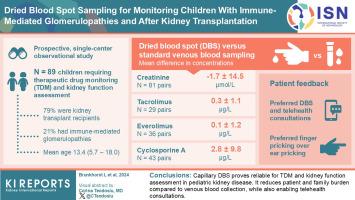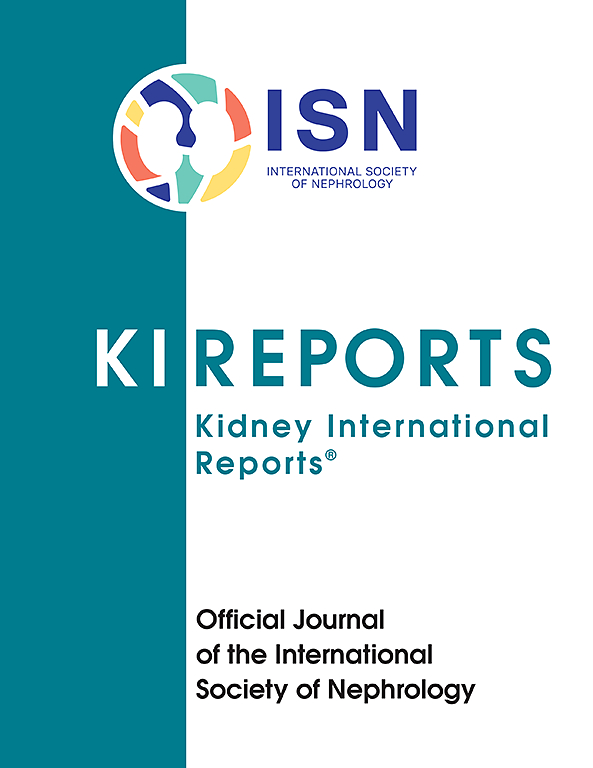干血斑采样用于监测免疫相关性肾小球疾病患儿和肾移植后的情况
IF 5.7
2区 医学
Q1 UROLOGY & NEPHROLOGY
引用次数: 0
摘要
由于频繁的静脉穿刺和门诊,对肾移植术后或患有肾小球疾病的儿童进行肾功能和免疫抑制剂水平的监测具有挑战性。毛细管干血斑采样(DBS)提供了一种潜在的替代方法。在这项前瞻性单中心研究中,共纳入了 89 名需要进行治疗药物监测(TDM)和肾功能评估的儿童(38% 为女性,62% 为男性)。在这些患者中,79%是肾移植受者,21%患有免疫介导的肾小球疾病。平均年龄为 13.4 岁(5.7-18.0 岁)。研究人员同时采集了 DBS 和标准静脉血清样本,以检测他克莫司 (TAC)、环孢素 A (CsA)、依维莫司 (EVR) 和肌酐水平。此外,还通过问卷调查收集了患者对疼痛感和可行性的反馈意见。DBS 与标准方法的参数值无明显差异(肌酐,-1.7 ± 14.5 μmol/l;EVR,0.1 ± 1.2 μg/l;TAC,0.3 ± 1.1 μg/l;CsA,2.8 ± 9.8 μg/l)。与标准方法相比,DBS 具有足够的准确性。患者更青睐 DBS 和远程医疗咨询,特别是由于减少了旅行和缺课。与刺耳法相比,患者更喜欢手指刺入法。毛细血管 DBS 用于小儿肾病的 TDM 和肾功能评估证明是可靠的。与静脉采血相比,毛细血管 DBS 可减轻患者和家属的负担,并实现远程医疗会诊。本文章由计算机程序翻译,如有差异,请以英文原文为准。

Dried Blood Spot Sampling for Monitoring Children With Immune-Mediated Glomerulopathies and After Kidney Transplantation
Introduction
Monitoring kidney function and immunosuppressant levels in children post–kidney transplantation or those with glomerulopathies is challenging due to frequent venipunctures and clinic visits. Capillary dried blood spot sampling (DBS) offers a potential alternative.
Methods
In this prospective single-center study, 89 children (38% female and 62% male) requiring therapeutic drug monitoring (TDM) and kidney function assessment were enrolled. Of the patients, 79% were kidney transplant recipients, and 21% had immune-mediated glomerulopathies. The mean age was 13.4 (range, 5.7–18.0) years. DBS and standard venous serum samples were collected simultaneously for tacrolimus (TAC), cyclosporine A (CsA), everolimus (EVR), and creatinine levels. Furthermore, patient feedback on pain perception and feasibility was collected via questionnaire.
Results
No significant differences in parameter values between DBS and standard methods were observed (creatinine, −1.7 ± 14.5 μmol/l; EVR, 0.1 ± 1.2 μg/l; TAC, 0.3 ± 1.1 μg/l; CsA, 2.8 ± 9.8 μg/l). DBS demonstrated sufficient accuracy compared with standard methods. Patients favored DBS and telehealth consultations, especially due to less travel and school absences. Patients preferred finger pricking over ear pricking.
Conclusion
Capillary DBS proves reliable for TDM and kidney function assessment in pediatric kidney disease. It reduces patient and family burden compared with venous blood collection and enables telehealth consultations.
求助全文
通过发布文献求助,成功后即可免费获取论文全文。
去求助
来源期刊

Kidney International Reports
Medicine-Nephrology
CiteScore
7.70
自引率
3.30%
发文量
1578
审稿时长
8 weeks
期刊介绍:
Kidney International Reports, an official journal of the International Society of Nephrology, is a peer-reviewed, open access journal devoted to the publication of leading research and developments related to kidney disease. With the primary aim of contributing to improved care of patients with kidney disease, the journal will publish original clinical and select translational articles and educational content related to the pathogenesis, evaluation and management of acute and chronic kidney disease, end stage renal disease (including transplantation), acid-base, fluid and electrolyte disturbances and hypertension. Of particular interest are submissions related to clinical trials, epidemiology, systematic reviews (including meta-analyses) and outcomes research. The journal will also provide a platform for wider dissemination of national and regional guidelines as well as consensus meeting reports.
 求助内容:
求助内容: 应助结果提醒方式:
应助结果提醒方式:


